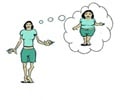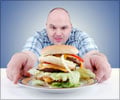Altered neural response in those with bulimia may explain why these individuals tend to remain driven to eat even when not hungry.

‘Adults with bulimia nervosa may have elevated reward-related brain activation in response to taste which keeps them wanting to eat more.’





"Our study suggests that adults with bulimia nervosa may have elevated reward-related brain activation in response to taste. This altered neural response may explain why these individuals tend to remain driven to eat even when not hungry," said Alice V. Ely, PhD, principal author of the study in the Department of Psychiatry at UC San Diego School of Medicine. The researchers looked at the insula, striatum, amygdala and anterior cingulate cortex -- brain regions involved in evaluating taste signals and integrating them with body cues (such as hunger) to drive behavior.
"We found that the areas of the brain that differed in the two study groups were the left insula, putamen and amygdala, which determine how rewarding a taste might be and how emotionally important it is. That information is then sent to parts of the brain that motivate eating," said Ely.
Twenty-six individuals with a history of BN and 22 without participated in the study. To measure brain activity, the group was administered water and a sucrose solution every 20 seconds for about 13 minutes following either a 16 hour fast or a standardized breakfast.
"We wanted to see how their brains reacted to different tastes and hunger states," said Ely.
Advertisement
"Brain activation in the left amygdala was actually significantly greater in the group with a history of bulimia nervosa than in the control group when fed, indicating that taste response in these individuals may be insensitive to the effects of energy metabolism, exaggerating the value of food reward," said Ely.
Advertisement
Nearly 5 million females and 2 million males in America suffer from BN. Current treatment options, including cognitive and behavioral therapies, are effective for about 30 to 50 percent of patients.
"Our study results may contribute to identifying neural mechanisms that will open the door to the use of new medications or other brain-based behavioral treatments," said Ely. "This is promising and hopeful news to those who suffer from eating disorders."
Source-Eurekalert















